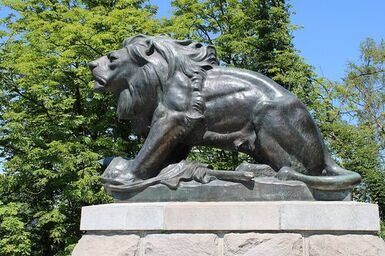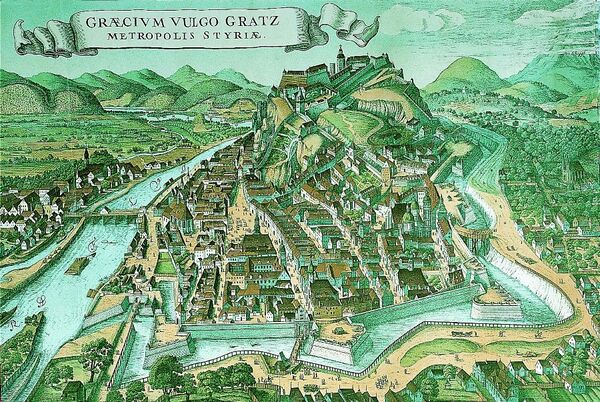One of many
The Napoleonic Wars is a period of history associated with many notable figures: The Duke of Wellington, Grouchy, MacDonald, Alexander I, of course Bonaparte, and many more. However, among these great men of history, there were also countless lesser-known individuals who performed deeds that, while perhaps not as grand, immortalized them in one way or another.
Among these individuals stands Franz Xaver Hackher, a member of the Austrian military during that time, who became a local celebrity in Graz and was immortalized as a statue of a lion.

Hackher was born into an old, small noble family from Lower Austria. Not much is known about his early life, but he eventually entered the k.u.k (imperial and royal) Technical Military Academy, where he received training as a military engineer. After graduating as a junior lieutenant, he participated in the Ottoman wars, during which he was promoted first to the rank of senior lieutenant and then to captain of the engineering corps.
He fought in the Siege of Mantua (1799), where the Austrian army defeated the French troops in the same city where they had suffered a devastating defeat three years prior.
Following his promotion to captain, Hackher was later promoted to lieutenant-colonel again.
The (not so) last stand of Major Hackher
When the French armies approached the city of Graz during the War of the Fifth Coalition Archduke Joseph withdrew his army from Graz. The defenders in Graz were told to hold back the French army under the command of Grouchy and MacDonald as long as possible to give the Archduke a head start.
When the French reached Graz negotiations started but Hackher decided to stall them, after a parliamentary urged them to just surrender the city. Eventually a peaceful surrender was negotiated, however Hackher insisted staying on the Castle Hill inside the city.

Castle Hill is a small but steep and fortified hill inside the city of Graz with casemates, an easy to defend strong-point. Grouchy eventually threatened the defenders by positioning artillery nearby but Hackher and his 900 defenders continued to hold out on the hill. Bombardment of the castle eventually started. The food stored in the casemates was rationed and while the city was already under firm French control small skirmished ensued.
After several day of French infantry attacks and artillery barrages that often lasted into the night French losses were around 300 casualties (mostly lightly wounded), while only 7 dead and 14 wounded Austrians are recorded. French attempts to blocked and dismantle bridges that led to the castle were partly successful, partly failed due to counter battery fire from defenders.
Gyulai arrives
Several days later, after the 20th of June the French General Broussier withdrew his troops from the city to meet the Austrian General Ignaz Gyulai, however no battle took place. Major Hackher retook the city gates and replenished his resources in the castle. The French forced Hackher again to fall back into to Castle Hill and the city fell back into French hands.
After Marmont reached the area with his troops Broussier consolidated his troops with Marmont’s army in the nearby village of Lieboch. However, Marmont received information that Gyulai reached Graz and ordered Broussier back to retake/hold the city.
A small battle ensured which eventually forced Gyylai to withdraw and allowed Marmont to march his army north to Vienna where he eventually fought in Wagram. If Gyulai had at that time managed to bind French troops to Styria, whether by defeating them close to Graz or simply withdrawing into the Graz-Styria axis Marmont might not have been able to participate in the Battle of Wagram - and it might have ended differently.
Aftermath
The castle on Castle Hill was later demolished as per the Treaty of Schönbrunn. Perhaps the castle might have survived if not for Hackher and his defenders.
Hackher was promoted to colonel and baron. He served under Carl XIV, also known as Jean Baptiste Bernadotte, and fought the French again in 1813-1814 where he’d receive the Swedish Order of the Sword.
He eventually retired and died in 1837.
A statue in his honor was commissioned and unveiled in 1909 but this memorial faced a temporary end when it was molten down in 1943 to produce weapons for the German war effort. A new one was made in 1966 and Hackher now stands again on top of Castle Hill, overlooking the city he had defended over 2 centuries ago.
Sources (in German):
- https://www.graz.at/cms/beitrag/10096078/7773004/Franz_Xaver_Hackher_zu_Hart_Militaer.html
- https://de.wikipedia.org/wiki/Belagerung_von_Graz
- https://www.grazinteressiertmich.at/denkspazierg%C3%A4nge/denkspazierg%C3%A4nge-2022/hackher-l%C3%B6we/
- https://austria-forum.org/af/AustriaWiki/Franz_Xaver_Hackher_zu_Hart